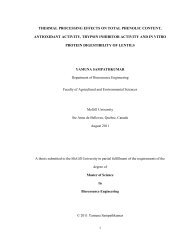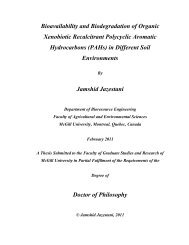Postharvest treatments to reduce chilling injury symptoms in stored ...
Postharvest treatments to reduce chilling injury symptoms in stored ...
Postharvest treatments to reduce chilling injury symptoms in stored ...
You also want an ePaper? Increase the reach of your titles
YUMPU automatically turns print PDFs into web optimized ePapers that Google loves.
gamma rays, electrons, X-rays and microwaves. Spald<strong>in</strong>g and von W<strong>in</strong>deguth (1988)<br />
reported that the percentage of decayed mango is m<strong>in</strong>imized when they are exposed <strong>to</strong><br />
750 Gy or higher, but fruit peel shows scald-like symp<strong>to</strong>ms with irradiation doses over<br />
500 Gy.<br />
Radiation also affected ripen<strong>in</strong>g, because of the specific biochemical processes.<br />
Accord<strong>in</strong>g <strong>to</strong> Spald<strong>in</strong>g and Reeder (1986), comb<strong>in</strong>ation of irradiation and HW (53 °C), or<br />
0.2 % hot imazalil (53 °C) was more effective for s<strong>to</strong>rage purposes. Gamma irradiation<br />
(30 Krad) caused ripen<strong>in</strong>g delay of seven days <strong>in</strong> comparison <strong>to</strong> mango s<strong>to</strong>red at room<br />
temperature.<br />
2.2.6 S<strong>to</strong>rage by us<strong>in</strong>g chemicals<br />
Treatment efficiency varies with <strong>in</strong>fection level and s<strong>to</strong>rage regime. The length of<br />
shelf life depends on cultivar, <strong><strong>in</strong>jury</strong>, maturity at harvest, calcium spray, and exposure <strong>to</strong><br />
ethylene (Anonymous, 1988, Coates et al, 1995). A dip <strong>in</strong> 4-6 % calcium chloride can<br />
<strong>in</strong>crease the shelf life of some cultivars (S<strong>in</strong>gh et al., 1993). Ethylene is used <strong>to</strong> <strong>reduce</strong><br />
time for ripen<strong>in</strong>g <strong>in</strong>itiation and it can also enhance sk<strong>in</strong> color of the fruit (S. P. Burg and<br />
Burg, 1962). In South Africa, a benomyl dip for 5 m<strong>in</strong> at 55 °C is recommended just after<br />
pick<strong>in</strong>g of fruits, which can control soft brown rot (Sepiah, 1986). Prochloraz also<br />
provides good protection from anthracnose and Alternaria rot <strong>in</strong> mango (Johnson and<br />
Coates, 1993). Prior <strong>to</strong> harvest Gibberellic acid (GA3) spray can retard mango ripen<strong>in</strong>g<br />
at ambient temperature for up <strong>to</strong> six days of s<strong>to</strong>rage (Khader, 1991). Calcium chloride<br />
treatment resulted <strong>in</strong> low ethylene production, low respiration, and helped <strong>to</strong> <strong>reduce</strong> the<br />
occurrence of s<strong>to</strong>rage decay (Eeden, 1992).<br />
2.3 <strong>Postharvest</strong> Heat Dis<strong>in</strong>festation Treatments<br />
For fresh mangoes postharvest heat dis<strong>in</strong>festation <strong>treatments</strong> have been well<br />
known over the past decades. Although heat has fungicidal and <strong>in</strong>secticidal action it often<br />
has detrimental effect on the crop. The fruit is heated for a def<strong>in</strong>ed period of time <strong>to</strong><br />
ensure the energy gets transferred from the heat<strong>in</strong>g medium <strong>to</strong> the fruit. The heat<strong>in</strong>g<br />
medium used may be air or water. In 1989, Couey reported that heat-<strong>treatments</strong> are used<br />
<strong>to</strong> control postharvest diseases and <strong>in</strong>sect pest. This method is cheap and environmentally<br />
13









